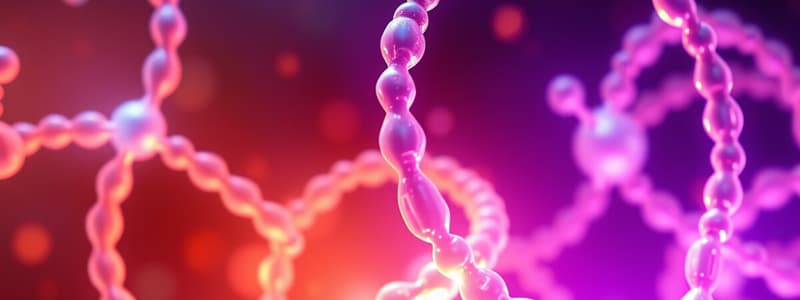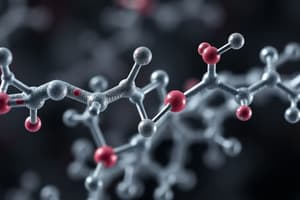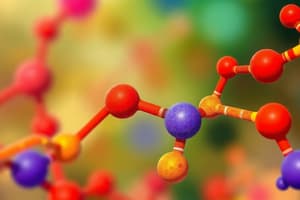Podcast
Questions and Answers
What are the classes of the large molecules that all living things fall into?
What are the classes of the large molecules that all living things fall into?
- Lipids (correct)
- Proteins (correct)
- Nucleic acids (correct)
- Carbohydrates (correct)
What is a macromolecule?
What is a macromolecule?
A giant molecule formed by the joining of smaller molecules, usually by a dehydration reaction.
Define polymer.
Define polymer.
A long molecule consisting of many similar or identical monomers linked by covalent bonds.
Define monomer.
Define monomer.
What type of reaction connects monomers?
What type of reaction connects monomers?
Polymers are converted to monomers in what type of reaction?
Polymers are converted to monomers in what type of reaction?
What does the root word 'hydro' mean?
What does the root word 'hydro' mean?
What does the root word 'lysis' mean?
What does the root word 'lysis' mean?
Is glucose a monomer or a polymer?
Is glucose a monomer or a polymer?
When two monomers are joined, what molecule is always removed?
When two monomers are joined, what molecule is always removed?
What are the monomers of all carbohydrates?
What are the monomers of all carbohydrates?
What is the formula of a hexose sugar?
What is the formula of a hexose sugar?
What is the difference between aldehyde sugar and ketone sugar?
What is the difference between aldehyde sugar and ketone sugar?
Which two monosaccharides form maltose?
Which two monosaccharides form maltose?
Which two monosaccharides are involved in the formation of carbohydrates in plants?
Which two monosaccharides are involved in the formation of carbohydrates in plants?
Which two monosaccharides form sucrose?
Which two monosaccharides form sucrose?
Which two monosaccharides form lactose?
Which two monosaccharides form lactose?
What is glycosidic linkage?
What is glycosidic linkage?
What are the two types of polysaccharide?
What are the two types of polysaccharide?
Provide examples of starch.
Provide examples of starch.
Provide examples of glycogen.
Provide examples of glycogen.
Why can't humans digest cellulose? What organisms can?
Why can't humans digest cellulose? What organisms can?
What is cellulose?
What is cellulose?
What is glycogen?
What is glycogen?
What forms maltose?
What forms maltose?
What is 'milk sugar'?
What is 'milk sugar'?
What is the structural polysaccharide that gives cockroaches their crunch?
What is the structural polysaccharide that gives cockroaches their crunch?
What characteristic do all lipids share?
What characteristic do all lipids share?
What is included in the term lipid?
What is included in the term lipid?
If a fat is composed of three fatty acids and one glycerol molecule, how many water molecules will be removed to form it?
If a fat is composed of three fatty acids and one glycerol molecule, how many water molecules will be removed to form it?
Name two saturated fats.
Name two saturated fats.
What are the building blocks of fat and how do you draw an unsaturated fat?
What are the building blocks of fat and how do you draw an unsaturated fat?
Name two unsaturated fats.
Name two unsaturated fats.
Why are many unsaturated fats liquid at room temperature?
Why are many unsaturated fats liquid at room temperature?
What is a trans fat?
What is a trans fat?
List four functions of fats.
List four functions of fats.
Why are the tails hydrophobic on a phospholipid?
Why are the tails hydrophobic on a phospholipid?
Which of the two fatty acid chains in a phospholipid is unsaturated?
Which of the two fatty acid chains in a phospholipid is unsaturated?
What is a phospholipid?
What is a phospholipid?
What are examples of steroids?
What are examples of steroids?
Summarize five types of proteins.
Summarize five types of proteins.
What is represented by R in amino acids?
What is represented by R in amino acids?
What is a peptide bond?
What is a peptide bond?
What is a dipeptide?
What is a dipeptide?
Define polypeptide.
Define polypeptide.
What is primary protein structure?
What is primary protein structure?
What is secondary protein structure?
What is secondary protein structure?
What is an alpha helix?
What is an alpha helix?
What is a beta pleated sheet?
What is a beta pleated sheet?
What is tertiary protein structure?
What is tertiary protein structure?
Define quaternary protein structure.
Define quaternary protein structure.
Explain sickle cell anemia.
Explain sickle cell anemia.
Besides mutation, what else changes the primary structure of a protein?
Besides mutation, what else changes the primary structure of a protein?
What are the three components of a nucleotide?
What are the three components of a nucleotide?
What is the shape of DNA called?
What is the shape of DNA called?
Why are the strands of DNA called antiparallel?
Why are the strands of DNA called antiparallel?
What two molecules make up the 'uprights' of the DNA structure?
What two molecules make up the 'uprights' of the DNA structure?
What molecules make up the rungs of DNA?
What molecules make up the rungs of DNA?
Flashcards are hidden until you start studying
Study Notes
Classes of Large Biological Molecules
- Four main classes: carbohydrates, proteins, nucleic acids, and lipids.
Macromolecules
- Giant molecules made by joining smaller units through dehydration reactions.
Monomers and Polymers
- Monomer: building blocks of polymers.
- Polymer: long chains of repeating monomers linked by covalent bonds.
Dehydration and Hydrolysis Reactions
- Dehydration reaction connects monomers by removing water.
- Hydrolysis breaks polymers into monomers by adding water.
Carbohydrates
- Monosaccharides are the monomers of carbohydrates (e.g., glucose).
- Hexose sugar formula is C6H12O6, indicating a 1:2:1 ratio.
- Aldehyde sugars have carbonyl groups at the end (e.g., glucose), while ketone sugars have them in the middle (e.g., fructose).
Disaccharides
- Maltose is composed of two glucose molecules.
- Sucrose is formed from glucose and fructose.
- Lactose is made from glucose and galactose.
Polysaccharides
- Types include starch and glycogen, which serve as energy storage.
- Cellulose has 1-4 β-glucose linkages and is a structural component of plant cells.
Lipids
- Lipids are hydrophobic and include fats, oils, phospholipids, waxes, and steroids.
- Fats consist of three fatty acids and one glycerol; dehydration removes one water molecule to form them.
Saturated and Unsaturated Fats
- Saturated fats are solid at room temperature (e.g., lard, butter).
- Unsaturated fats are liquid at room temperature due to cis double bonds causing kinks (e.g., olive oil).
Phospholipids
- Structure includes glycerol, phosphate group, and two fatty acid chains; hydrophobic tails and hydrophilic heads.
- Phospholipids form bilayers in aqueous environments.
Proteins
- Functions: enzymatic, storage, hormonal, structural, and defensive.
- Amino acids are linked by peptide bonds through dehydration reactions.
- Protein structure levels: primary (amino acid sequence), secondary (coiling or folding), tertiary (overall shape due to side chain interactions), quaternary (assembly of multiple polypeptides).
Sickle Cell Anemia
- Caused by a mutation replacing glutamic acid with valine in hemoglobin, affecting oxygen transport efficiency.
Nucleic Acids
- Two types: DNA and RNA.
- DNA nitrogenous bases: cytosine, thymine, adenine, guanine; RNA bases: cytosine, uracil, adenine, guanine.
- Nucleotide components: nitrogen-containing base, 5-carbon sugar (ribose or deoxyribose), and one or more phosphate groups.
- DNA structure: double helix with antiparallel strands formed by sugar-phosphate backbone and hydrogen-bonded bases forming rungs.
Studying That Suits You
Use AI to generate personalized quizzes and flashcards to suit your learning preferences.




